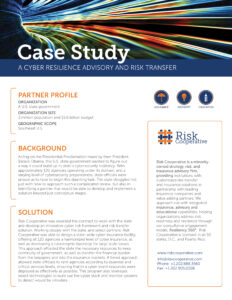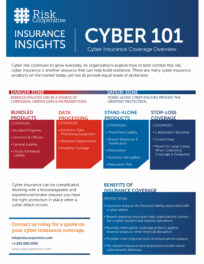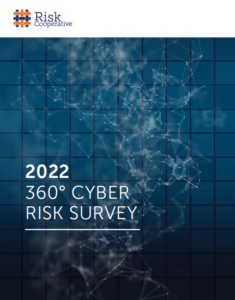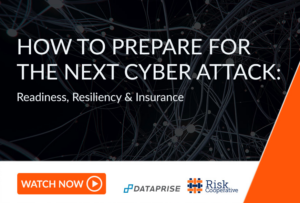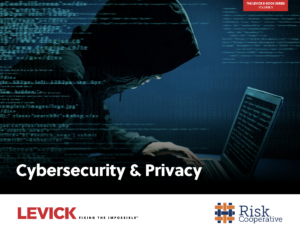Advisory Services
Cyber Risk Mitigation
Organizations the world over struggle with how to properly manage and quantify their cyber risk. As the world becomes more digitized and interconnected, cyber risks will only continue to grow.
From the more traditional cyber breaches, data exfiltration, ransomware and extortion attacks to more recently developed deep fakes and social engineering programs aimed at defrauding and stealing from organizations, the cyber landscape only continues to grow more complex. Cyber-attacks can put smaller companies out of business, and cause significant business interruptions, regulatory and privacy issues, reputational damage and more.
Risk Cooperative serves organizations across a wide range of industries to build up their cyber resiliency, and implement pro-active cyber risk management strategies. Our approach encompasses a multi-faceted methodology, leveraging risk management techniques and risk transfer solutions coupled with training and technology partners. We build a comprehensive defense that evaluates and strengthens all the core components of best-in-class cyber risk management including strategy, governance, risk management and ongoing monitoring. This approach goes beyond simply checking the compliance box, and helps organizations adequately quantify the true impact and financial costs of a potential cyber-attack.
Cyber Solutions
Cyber Risk Assessments and Analysis
Evaluates an organization’s overall cybersecurity framework, in conjunction with the organization’s risk profile. This model helps to establish a baseline standard and develop an actionable roadmap for improvement.
Cyber Breach Response Plan Design
Works with organizations to develop tailored cyber response plans to effectively manage a potential cyber breach scenario.
Cyber Awareness Training
Provides a broad set of training platforms to stress test an organization’s overall cyber preparedness as well as reinforce best-in-class cyber practices. Training ranges from customized tabletop exercises, online training modules, cyber siege simulations and scenario stress testing capabilities.
Third Party / Vendor Cyber Risk Analysis
Intangible threats, such as cyber, reputational risk and supply chain or third-party relationships often go unmeasured because of their amorphous nature. Putting precise figures around Value@risk, as well as correlations and dependencies, can help improve business continuity planning and correct hedging and recovery strategies. Working closely with clients, we work to establish standardized controls and management processes that enable organizations to effectively reduce cyber supply chain risks.
Enterprise Value at Risk
All too often, risk management approaches falter on their inability to offer precise measures of financial, economic or operational business impacts. Our Enterprise Value@Risk measures remove the ambiguity from intangible risks and emerging threats, like cyber risk, among others.
Cyber Risk Transfer Solution Development
Our team has extensive knowledge and capabilities to develop unique cyber insurance and risk transfer programs. While most traditional cyber insurance programs focus on a one-size-fits-all model, we work with clients to develop customized solutions that address their most pressing concerns. From stand alone cyber insurance and breach response programs, to intellectual property and catastrophic loss programs, our team works to develop the right solution for each client.
Cyber Risk Assessments and Analysis
Evaluates an organization’s overall cybersecurity framework, in conjunction with the organization’s risk profile. This model helps to establish a baseline standard and develop an actionable roadmap for improvement.
Cyber Breach Response Plan Design
Works with organizations to develop tailored cyber response plans to effectively manage a potential cyber breach scenario.
Cyber Awareness Training
Provides a broad set of training platforms to stress test an organization’s overall cyber preparedness as well as reinforce best-in-class cyber practices. Training ranges from customized tabletop exercises, online training modules, cyber siege simulations and scenario stress testing capabilities.
Third Party / Vendor Cyber Risk Analysis
Intangible threats, such as cyber, reputational risk and supply chain or third-party relationships often go unmeasured because of their amorphous nature. Putting precise figures around Value@risk, as well as correlations and dependencies, can help improve business continuity planning and correct hedging and recovery strategies. Working closely with clients, we work to establish standardized controls and management processes that enable organizations to effectively reduce cyber supply chain risks.
Enterprise Value at Risk
All too often, risk management approaches falter on their inability to offer precise measures of financial, economic or operational business impacts. Our Enterprise Value@Risk measures remove the ambiguity from intangible risks and emerging threats, like cyber risk, among others.
Cyber Risk Transfer Solution Development
Our team has extensive knowledge and capabilities to develop unique cyber insurance and risk transfer programs. While most traditional cyber insurance programs focus on a one-size-fits-all model, we work with clients to develop customized solutions that address their most pressing concerns. From stand alone cyber insurance and breach response programs, to intellectual property and catastrophic loss programs, our team works to develop the right solution for each client.
Resource Library
This latest 360° Cyber Risk Survey report provides the most current benchmarked data, informed analysis, and actionable best practices to help middle-market organizations, senior leaders, and boards of directors obtain a better understanding of the operational and financial impacts of cyber risks and a roadmap toward better operational resiliency. Read online, or download.
This latest 360° Cyber Risk Survey report provides the most current benchmarked data, informed analysis, and actionable best practices to help middle-market organizations, senior leaders, and boards of directors obtain a better understanding of the operational and financial impacts of cyber risks and a roadmap toward better operational resiliency.
Read online, or download.
In the wake of headline-grabbing attacks like SolarWinds, Colonial Pipeline and Kaseya, cybersecurity is a top concern for businesses of all sizes. And the costs for recovery are rising. “The risks are intensifying at a really alarming rate,” says Dataprise CEO, Steve Lewis. With both state-sponsored hackers and garden-variety criminals experiencing great success targeting firms with ransomware and other cybersecurity threats, the risk landscape is quite serious.
Frequent Cyber Attacks Are Impacting the Cyber Insurance Markets
According to Andres Franzetti, Co-founder and CEO of Risk Cooperative, “A couple of years ago, cyber used to be about large scale data breaches around PII and PHI. What we’re seeing now is that the drivers of loss have shifted to business interruption and shutting down organizations around ransomware – and the costs have gone up.” Statistics from Allianz Insurance cyber claims data indicate that the average cost of cyber crime has increased 70% even as the number of cyber incidents has been going up year over year, and business interruption losses account for the majority of claims.
These factors are impacting the market’s profitability as underwriters struggle to price risk accurately. Even as firms increasingly turn to cyber insurance for protection, the rate of claims has resulted in insufficient premiums to cover losses. To counter this dynamic, insurers are raising rates, limiting coverage, excluding certain risks, and exiting high risk and non-profitable markets. Without robust cybersecurity policies in place, firms are no longer able to apply for cyber insurance.
Effective, Resilient IT Infrastructure Is Table Stakes
Effective cybersecurity is the only way to effectively protect your company and its data. Yet, Steve warns, “You have to assume your cybersecurity is going to fail because, at the end of the day, there are thousands of hackers.” There is no silver bullet among the vast array of firms offering cyber protection.
The risk of an attacker breaching your cyber defenses requires strategies for business continuity and disaster recovery involving the integration of technology, policies, procedures, controls, processes, systems, management, and culture. With cyber insurance exclusions expanding, to truly be safe, you need an IT team that can whittle the huge number of potential threats down to the most existential ones, and then respond in real time. Staying ahead of hackers requires multidisciplinary cybersecurity expertise integrated and aligned with your enterprise-wide IT management strategy.
Strategies for Building Cyber Resilience
Yet, an organization will have difficulty achieving resilience without a clear understanding of their assets, which often include data that could be more valuable to the business operations than physical equipment. Andres reveals, “For us, resiliency is about operational continuity, and insurance helps to facilitate that, but it’s about analyzing your assets and what’s at risk in a cyber attack.” Understanding the hidden costs of a breach, like operational disruption and lost reputation, intellectual property and business relationships will help to ensure proper insurance limits and cybersecurity investments.
In the simplest terms, cyber insurance provides coverage to transfer and mitigate financial costs incurred because of a cyber incident as well as provide critical breach response resources during a cyber event. There are a range of cyber policies available, but not all policies provide equal coverage. Stand alone cyber policies, in contrast to bundled programs, provide robust breach response resources and coverage for a variety of potential loss scenarios.
Because cyber risk overlaps many business areas, and the frequency and cost of claims is rising, insurance carriers are excluding some types of exposures. Notably, the failure to maintain minimum security standards on traditional IT, portable devices and 3rd party security can lead to claims being denied. On the other hand, working with underwriter-approved Managed Security Service Providers (MSSP’s) can lead to lower premiums and more robust coverages. Securing cyber insurance creates access to more than just financial risk transfer, these policies often provide a range of proactive and risk mitigation services such as training, workshops, and assessments.
Conclusion
“Every organization, regardless of size, needs to look at cyber as a strategic business risk. Everyone is potentially vulnerable,” says Andres. With the growing climate of ransomware attacks and other cybersecurity incidents, now is the time to look into your organization and ask, are we properly prepared?
VIEW THE WEBINAR RECORDING:
How to Prepare for the Next Cyber Attack: Readiness, Resiliency & Insurance
CYBER 101 RESOURCE LIBRARY:
Cyber Insurance Coverage Overview
Minimum Cybersecurity Checklist
Sample Technical Specifications
Have questions? Send us a message.
The newest volume of the Levick eBook series features a collection of articles and broadcast sessions around the topics of cybersecurity and privacy. Risk Cooperative CEO Andres Franzetti spoke with Richard Levick in a session of What’s Working in Washington called True Costs of Hacking about the real impact of hacking, collateral damage, the integrity of […]
The newest volume of the Levick eBook series features a collection of articles and broadcast sessions around the topics of cybersecurity and privacy. Risk Cooperative CEO Andres Franzetti spoke with Richard Levick in a session of What’s Working in Washington called True Costs of Hacking about the real impact of hacking, collateral damage, the integrity of information, and the real costs of cybersecurity.
Read online, or download.
Subscribe to Insights Newsletter
The onset of the COVID-19 pandemic has challenged organizations to create accessible and productive remote workplaces on short notice. As organizations confront the business continuity pressures the pandemic has brought, the rapid adjustment to telework is exposing critical risks. Has your team answered these questions? Do we have the right cybersecurity measures in place? Have […]
The onset of the COVID-19 pandemic has challenged organizations to create accessible and productive remote workplaces on short notice. As organizations confront the business continuity pressures the pandemic has brought, the rapid adjustment to telework is exposing critical risks.
Has your team answered these questions?
- Do we have the right cybersecurity measures in place?
- Have we educated our staff on current cyber threats and cyber hygiene?
- Do we know if our cyber insurance policy applies to telecommuters?
- How can we best support struggling clients and employees?
- What is the plan for office re-entry once the crisis has passed?
Risk Cooperative’s Chief Revenue Officer, Les Williams, was joined by Austin Berglas, BlueVoyant’s Global Head of Professional Services to outline the scope of the challenge and offer their expertise.
Cyber threats continue to cause concern for organizations large and small. While companies continue to work on their resilience and reduce their overall cyber risk, the hard truth is that the adversary may still be successful. Recently, 22 towns across Texas were hit with a ransomware attack, which crippled key city services. These towns are […]
Cyber threats continue to cause concern for organizations large and small. While companies continue to work on their resilience and reduce their overall cyber risk, the hard truth is that the adversary may still be successful. Recently, 22 towns across Texas were hit with a ransomware attack, which crippled key city services. These towns are just the latest in a long string of victims — across both the public and private sectors — that have been devastated by cyber attacks.
This begs the question: What types of safeguards are available to help recover from such an attack? One popular option for organizations to manage their cyber risk is by having a cyber insurance policy. CyberVista recently sat down with Les Williams, Co-Founder and Chief Revenue Officer at Risk Cooperative — a strategy, risk, and insurance advisory firm — to discuss the importance of cyber insurance and what organizations should be looking for in their policies. Take a look at what advice he has to say in this excerpt from the CyberVista subject matter expert interview.
In today’s modern frictionless economy, the principal requisite for growth and order is the free flow of sensitive information, banking transactions and private data on a global scale. With this shift brought on by the unrelenting growth of ecommerce and mobile platforms comes the nagging reality that cyber risk is here to stay. Read More
In today’s modern frictionless economy, the principal requisite for growth and order is the free flow of sensitive information, banking transactions and private data on a global scale.
With this shift brought on by the unrelenting growth of ecommerce and mobile platforms comes the nagging reality that cyber risk is here to stay.
Cyber Solutions
Cyber Risk Assessments and Analysis
Evaluates an organization’s overall cybersecurity framework, in conjunction with the organization’s risk profile. This model helps to establish a baseline standard and develop an actionable roadmap for improvement.
Cyber Breach Response Plan Design
Works with organizations to develop tailored cyber response plans to effectively manage a potential cyber breach scenario.
Cyber Awareness Training
Provides a broad set of training platforms to stress test an organization’s overall cyber preparedness as well as reinforce best-in-class cyber practices. Training ranges from customized tabletop exercises, online training modules, cyber siege simulations and scenario stress testing capabilities.
Third Party / Vendor Cyber Risk Analysis
Intangible threats, such as cyber, reputational risk and supply chain or third-party relationships often go unmeasured because of their amorphous nature. Putting precise figures around Value@risk, as well as correlations and dependencies, can help improve business continuity planning and correct hedging and recovery strategies. Working closely with clients, we work to establish standardized controls and management processes that enable organizations to effectively reduce cyber supply chain risks.
Enterprise Value at Risk
All too often, risk management approaches falter on their inability to offer precise measures of financial, economic or operational business impacts. Our Enterprise Value@Risk measures remove the ambiguity from intangible risks and emerging threats, like cyber risk, among others.
Cyber Risk Transfer Solution Development
Our team has extensive knowledge and capabilities to develop unique cyber insurance and risk transfer programs. While most traditional cyber insurance programs focus on a one-size-fits-all model, we work with clients to develop customized solutions that address their most pressing concerns. From stand alone cyber insurance and breach response programs, to intellectual property and catastrophic loss programs, our team works to develop the right solution for each client.
Cyber Risk Assessments and Analysis
Cyber Breach Response Plan Design
Cyber Awareness Training
Third Party / Vendor Cyber Risk Analysis
Enterprise Value at Risk
Cyber Risk Transfer Solution Development
Cyber Risk Assessments and Analysis | Evaluates an organization’s overall cybersecurity framework, in conjunction with the organization’s risk profile. This model helps to establish a baseline standard and develop an actionable roadmap for improvement.
Cyber Breach Response Plan Design | Works with organizations to develop tailored cyber response plans to effectively manage a potential cyber breach scenario.
Cyber Awareness Training | Provides a broad set of training platforms to stress test an organization’s overall cyber preparedness as well as reinforce best-in-class cyber practices. Training ranges from customized tabletop exercises, online training modules, cyber siege simulations and scenario stress testing capabilities.
Third Party/Vendor Cyber Risk Analysis | Intangible threats, such as cyber, reputational risk and supply chain or third-party relationships often go unmeasured because of their amorphous nature. Putting precise figures around Value@risk, as well as correlations and dependencies, can help improve business continuity planning and correct hedging and recovery strategies. Working closely with clients, we work to establish standardized controls and management processes that enable organizations to effectively reduce cyber supply chain risks.
Enterprise Value at Risk | All too often, risk management approaches falter on their inability to offer precise measures of financial, economic or operational business impacts. Our Enterprise Value@Risk measures remove the ambiguity from intangible risks and emerging threats, like cyber risk, among others.
Cyber Risk Transfer Solution Development | Our team has extensive knowledge and capabilities to develop unique cyber insurance and risk transfer programs. While most traditional cyber insurance programs focus on a one-size-fits-all model, we work with clients to develop customized solutions that address their most pressing concerns. From stand alone cyber insurance and breach response programs, to intellectual property and catastrophic loss programs, our team works to develop the right solution for each client

